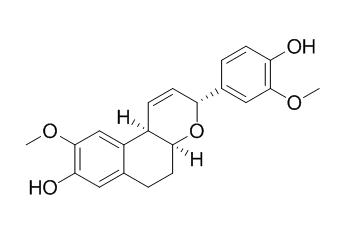Musellarin B
Musellarin B is cytotoxic toward several of the human tumor cell lines (HL-60, SMMC-7721, A-549, MCF-7, and SW480).
Inquire / Order:
manager@chemfaces.com
Technical Inquiries:
service@chemfaces.com
Tel:
+86-27-84237783
Fax:
+86-27-84254680
Address:
1 Building, No. 83, CheCheng Rd., Wuhan Economic and Technological Development Zone, Wuhan, Hubei 430056, PRC
Providing storage is as stated on the product vial and the vial is kept tightly sealed, the product can be stored for up to
24 months(2-8C).
Wherever possible, you should prepare and use solutions on the same day. However, if you need to make up stock solutions in advance, we recommend that you store the solution as aliquots in tightly sealed vials at -20C. Generally, these will be useable for up to two weeks. Before use, and prior to opening the vial we recommend that you allow your product to equilibrate to room temperature for at least 1 hour.
Need more advice on solubility, usage and handling? Please email to: service@chemfaces.com
The packaging of the product may have turned upside down during transportation, resulting in the natural compounds adhering to the neck or cap of the vial. take the vial out of its packaging and gently shake to let the compounds fall to the bottom of the vial. for liquid products, centrifuge at 200-500 RPM to gather the liquid at the bottom of the vial. try to avoid loss or contamination during handling.
Mie University2019, 10076.
J Biol Chem.2021, 297(6):101362.
Phytomedicine.2016, 23(4):331-9
Heliyon.2024, 10(12):e31722.
Int J Biol Macromol.2021, 199:189-200.
Front Pharmacol.2019, 10:1025
Pharmaceuticals (Basel).2021, 14(6):588.
J Korean Soc Food Sci Nutr2023, 52(11):1101-1110
Int J Mol Sci.2021, 22(8):4211.
FEBS Lett.2021, 595(20):2608-2615.
Related and Featured Products
Nat Prod Bioprospect. 2011 August; 1(1): 41–47.
Chemical constituents from the aerial parts of Musella lasiocarpa.[Reference:
WebLink]
METHODS AND RESULTS:
Phytochemical investigation of the aerial parts of the monotypic plant, Musella lasiocarpa, led to the isolation of four rare bicyclic diarylheptanoids, Musellarin B,musellarin C, musellarin D, musellarin E (2–5), two new phenylphenalenones, 2-methoxy-9-(3′,4′-dihydroxyphenyl)-1Hphenalen-1-one (9), 2-methoxy-9-(3′-methoxy-4′-hydroxyphenyl)-1H-phenalen-1-one (10), a new acenaphtylene derivative, trans-(1S,2S)-3-(4′-methoxyphenyl)-acenaphthene-1,2-diol (13), and two new sucrose esters, 1,2′,3′,4′,6′-O-pentaacetyl-3-O-trans-pcoumaroylsucrose (16), 1,2′,3′,4′,6′-O-pentaacetyl-3-O-cis-p-coumaroylsucrose (17), together with nine known compounds. In addition, (4E,6E)-1-(3′,4′-dihydroxyphenyl)-7-(4″-hydroxyphenyl)-hepta-4,6-dien-3-one (15) was isolated for the first time from a natural source. The structures of new compounds were elucidated by analysis of their spectroscopic data.
CONCLUSIONS:
Compounds 2, 6, 8–10, 12, and 14 were cytotoxic toward several of the human tumor cell lines (HL-60, SMMC-7721, A-549, MCF-7, and SW480). Of these, the new compound 9 was the most potent one, with IC50 values of 5.8, 10.3, 6.3, 3.3, and 2.3 μM, respectively.
Chemistry. 2015 Jul 27;21(31):11152-7.
Highly trans-selective arylation of Achmatowicz rearrangement products by reductive γ-deoxygenation and Heck-Matsuda reaction: asymmetric total synthesis of (-)-musellarins A-C and their analogues.[Pubmed:
26104266 ]
Fully functionalized pyranuloses derived from Achmatowicz rearrangement (AR) are versatile building blocks in organic synthesis. However, access to trans-2,6-dihydropyrans from pyranuloses remains underexplored.
METHODS AND RESULTS:
Herein, we report a new two-step trans arylation of AR products to access 2,6-trans-dihydropyranones. This new trans-arylation method built on numerous plausible, but unsuccessful, direct arylation reactions, including Ferrier-type and Tsuji-Trost-type reactions, was finally enabled by an unprecedented, highly regioselective γ-deoxygenation of AR products by using Zn/HOAc and a diastereoselective Heck-Matsuda coupling. The synthetic utility of the reaction was demonstrated in the first asymmetric total synthesis of (-)-musellarin A, (-)-Musellarin B, (-)-musellarin C and 12 analogues in 11-12 steps.
CONCLUSIONS:
The brevity and efficiency of our synthetic route permitted preparation of enantiomerically pure musellarins and analogues (>20 mg) for preliminary cytotoxicity evaluation, which led us to identify two analogues with three-to-six times greater potency than the musellarins as promising new leads.



